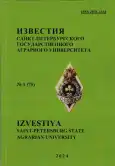Ontogenesis Intensity and Milk Productivity of Holstein First-Calving Cows
- Авторлар: Skakunova K.A.1, Grachev V.S.1, Braginets S.A.1
-
Мекемелер:
- Saint-Petersburg State Agrarian University
- Шығарылым: № 1(75) (2024)
- Беттер: 87-94
- Бөлім: Animal science and veterinary medicine
- URL: https://bakhtiniada.ru/2078-1318/article/view/304755
- DOI: https://doi.org/10.24412/2078-1318-2024-1-87-94
- ID: 304755
Дәйексөз келтіру
Толық мәтін
Аннотация
The article deals with the indicators of ontogenesis of dairy heifers at different age periods expressed in live weight, analyses the measurements of first-calf heifers and their milk productivity indicators. The research includes data on 1571 animals of Holstein breed in one of the outstanding modern farms - breeding plant 'Detskoselsky'. It is found that the live weight of heifers at different ages is quite equalized (coefficients of variability are at the level of 3,68-7,54%). The analysis of the main measurements of the first heifers shows that all animals are large enough, the variability of measurements is not high (2,87-3,85%). Breast girth was the least variable. Analyses of the relationship between live weight at different ages and milk yield in the first lactation showed that in general it is practically absent. Only a rather weak positive relationship (0,19) between live weight in the first lactation and milk yield was found. This indicates that more massive first heifers showed maximum milk yields, but this relationship was obviously curvilinear. The relationship between milk yield and measurements was more significant. Thus, the correlation coefficient of milk yield with oblique torso length was 0,25, and with torso girth 0,17. Accordingly, animals with a longer torso and slightly more massive animals showed maximum milk yields. Correlation coefficients between live weight at different ages (except live weight at birth) and age of first insemination were the most significant. Heifers inseminated earlier than others maintained high intensity of ontogenesis in all age periods. This makes it possible to select them for early maturity, starting from six months of age.
Негізгі сөздер
Авторлар туралы
K. Skakunova
Saint-Petersburg State Agrarian University
Email: skakunova-kristina@mail.ru
Postgraduate student of the Department of Genetics, Breeding and Biotechnology of Animals
Pushkin, Saint Petersburg, RussiaV. Grachev
Saint-Petersburg State Agrarian University
Email: grachev_vadim@mail.ru
Cand. Sci. (Biol.), Associate Professor of the Department of Genetics, Breeding and Biotechnology of Animals
Pushkin, Saint Petersburg, RussiaS. Braginets
Saint-Petersburg State Agrarian University
Хат алмасуға жауапты Автор.
Email: braginetssvetlana@gmail.com
Cand. Sci. (Biol.), Associate Professor, Head of the Department of Animal Genetics, Breeding and Biotechnology of Animals
Pushkin, Saint Petersburg, RussiaӘдебиет тізімі
- Grachev, V.S., Braginets, S.A., Alekseeva, A.Y. (2020). ‘Analysis of the influence of various factors on productivity and longevity of dairy cattle’, Izvestiya of Saint-Petersburg State Agrarian University, vol. 61, no. 4, pp. 73–79 (In Russ.). doi: 10.24411/2078-1318-2020- 14073.
- Chargeishvili, S.V., Ivanov, N.V., Zhuravleva, M.E. (2018). ‘Analysis of factors affecting milk productivity of cows in the conditions of a breeding farm’. Herald of Agroindustrial complex of Upper Volga region, vol. 41, no.1, pp. 22–26 (In Russ.).
- Pavlova, T.V. (2021). ‘Influence of genotype and intensity of cow formation on the level of their milk productivity’. Herald of Agroindustrial complex of Upper Volga region, no. 1, pp. 19-23. (In Russ.). doi: 10.35694/YARCX.2021.53.1.003.
- Oleinik, S.A., Yershov, A.M. (2023). ‘Dairy productivity of black-breed heifers with regard to the intensity of their breeding and type of physique’. Agrarian Bulletin of the North Caucasus, vol. 50, no. 2, pp. 19–23. (In Russ.). doi: 10.31279/222-9345-2023-13-50-17-22.
- Han, L., Heinrichs, A.J., De Vries A., Dechow, C.D. (2021). ‘Relationship of body weight at first calving with milk yield and herd life’, Journal of Dairy Science, vol. 104, no. 1, pp. 397– 404. Doi: https://doi.org/10.3168/jds.2020-19214.
- Haworth, G.M, Tranter, W.P, Chuck, J.N, Cheng, Z, Wathes, D.C. (2008). ‘Relationships between age at first calving and first lactation milk yield, and lifetime productivity and longevity in dairy cows’. Veterinary Record, vol. 162, no. 20, pp. 643–647. Doi: https://doi.org/10.1136/vr.162.20.643.
- Komkov, D.G. (2019). ‘Prodolzhitel`nost` i intensivnost` ispol`zovaniya korov s razny`m vozrastom i zhivoj massoj pri pervom otele’, Molochnoe i myasnoe skotovodstvo, no. 7, pp. 42–45 (In Russ.).
- Sermyagin, A.A., Filipchenko, A.A., Ermilov, A.N., Yanchukov, I.N. (2018). ‘Parameters of growth and development of cows of black and feather and Holstein breeds in connection with productive longevity’, Far Eastern Agrarian Bulletin, vol. 48, no. 4, pp. 194–202 (In Russ.).
- Snigirev, S.O., Lamonov, S.A., Skorkina, I.A., Savenkova E.V. (2022) ‘Growth and development of repair heifers of Holstein breed of black-and-brown breed and Holsteinised heifers of black-and-brown breed’, Bulletin of Michurinsk state agrarian university, vol. 71, no. 4, pp. 153–157 (In Russ.).
- Mohd Nor, N., Steeneveld, W., van Werven, T., Mourits, M.C., Hogeveen, H. (2012) ‘First- calving age and first-lactation milk production on Dutch dairy farms’. Journal of Dairy Science, vol. 96, no. 2, pp. 981–992. Doi: https://doi.org/10.3168/jds.2012-5741.
- Shin, S., Lee, J., Do, C. (2021).‘Genetic relationship of age at first calving with conformation traits and calving interval in Hanwoo cows’. Journal of Animal Science and Technology, vol. 63, no. 4, pp. 740–750. Doi: https://doi.org/10.5187/jast.2021.e73.
- Boothby, F., Grove-White, D., Oikonomou, G., Oultram, J.W.H. (2020).‘Age at first calving in UK Jersey cattle and its associations with first lactation 305-day milk yield, lifetime daily milk yield, calving interval and survival to second lactation’. Veterinary Record, vol. 187, no. 12, pp. 491–491. Doi: https://doi.org/10.1136/vr.105993.
- Grachev, V.S. Biometricheskaya obrabotka danny`x zootexnicheskogo ucheta sredstvami EXCEL s ispol`zovaniem paketa analiza (metodicheskie ykazaniya). – SPb.: SPbGAU, 2012.
- – 48 p.
Қосымша файлдар









